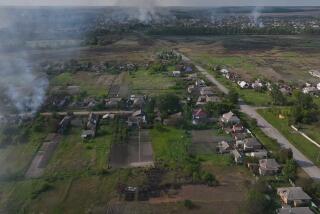Grotesque Parade in Vanquished Vukovar : Yugoslavia: Serbian officers lead reporters through carnage of the Croatian city.
- Share via
VUKOVAR, Croatia — The Serb-dominated Yugoslav army, whose big guns have smashed this Danube River city, conducted a grisly press tour Thursday of what is left of Vukovar and blamed its destruction on “Croatian fascism.”
The grotesque parade--during which corpses of Serbs with cleaved-open skulls and gouged-out eyes were displayed for reporters before luncheon was served in a bombed-out hotel--was punctuated by a long oration from a senior army colonel.
“I want you to remember what a town looks like after the Ustashe have been there,” said Col. Milan Gwerro, referring to Croatian defenders of Vukovar by the name of the World War II Croatian regime that collaborated with Nazi Germany. “I would ask you to see the fate of Vukovar as the reincarnation of fascism.”
Elsewhere in Yugoslavia there was talk of new peace moves, of a possible settlement in the five-month-old civil war between Serbs and Croats, but not here. Even as Gwerro was speaking, reports circulated among the three busloads of reporters that army tanks and heavy artillery that had flattened Vukovar were being repositioned to attack two nearby Croatian cities--Vincovci and Osijek.
Just 24 hours earlier, the leader of Serbian guerrilla forces who fought in the three-month battle for Vukovar said in a television interview that conquest of Croatian-held territory would continue. “We are going on,” said Zeljko Raznatovic, “on to Osijek,” the capital of northeastern Croatia and the republic’s fourth-largest city.
An end to the war also seemed remote from the minds of the army tour conductors, whose agenda apparently was to show the international press that the Croatian defenders of Vukovar were Hitler-loving, child-murdering, violence-provoking storm troopers.
As in many past Balkan wars, a major point of conflict in this one has been allegations by both sides of unspeakable atrocities by the enemy.
The first stop on the tour was the city’s army barracks, one of few clusters of buildings in Vukovar that are still habitable. Army guides declared that Croatian forces precipitated the military’s all-out assault on the city by laying siege to the barracks Sept. 30. “They fired 100 mortars a day for 20 days at the barracks,” said Lt. Col. Miodrag Panic, commander of the artillery brigade that wiped out most of Vukovar.
Panic said the army shelled Vukovar only to break the Croatian hold on the barracks, but that version of events is at odds with accounts of Western journalists who visited Vukovar a month before the barracks were encircled and who reported that the city already was being shelled daily by the army and its Serbian guerrilla allies.
The press buses then rolled on toward the center of Vukovar, but stopped briefly along a narrow road lined with shattered houses. There, Maj. Veselin Sljivancanin led television cameramen to a concrete-walled garage where he said 40 “Ustashe” militiamen had been stationed. Neatly painted on the walls were swastikas, pro-Hitler slogans and anti-Serb graffiti.
Later, as reporters clambered from the buses at the bombed-out city hospital, military guides informed them that “massacre victims are to the right.” In a nearby garden were the bodies of about 60 civilians, many of them elderly men and woman. Several appeared to have had their skulls chopped open with axes; others were missing limbs and eyes. The dead were identified by army officers as Serbs murdered by Croats.
“They were killed only because they were Serbs,” said a 16-year-old Serb guerrilla from Vukovar who was made available to reporters by the army.
More to Read
Sign up for Essential California
The most important California stories and recommendations in your inbox every morning.
You may occasionally receive promotional content from the Los Angeles Times.













